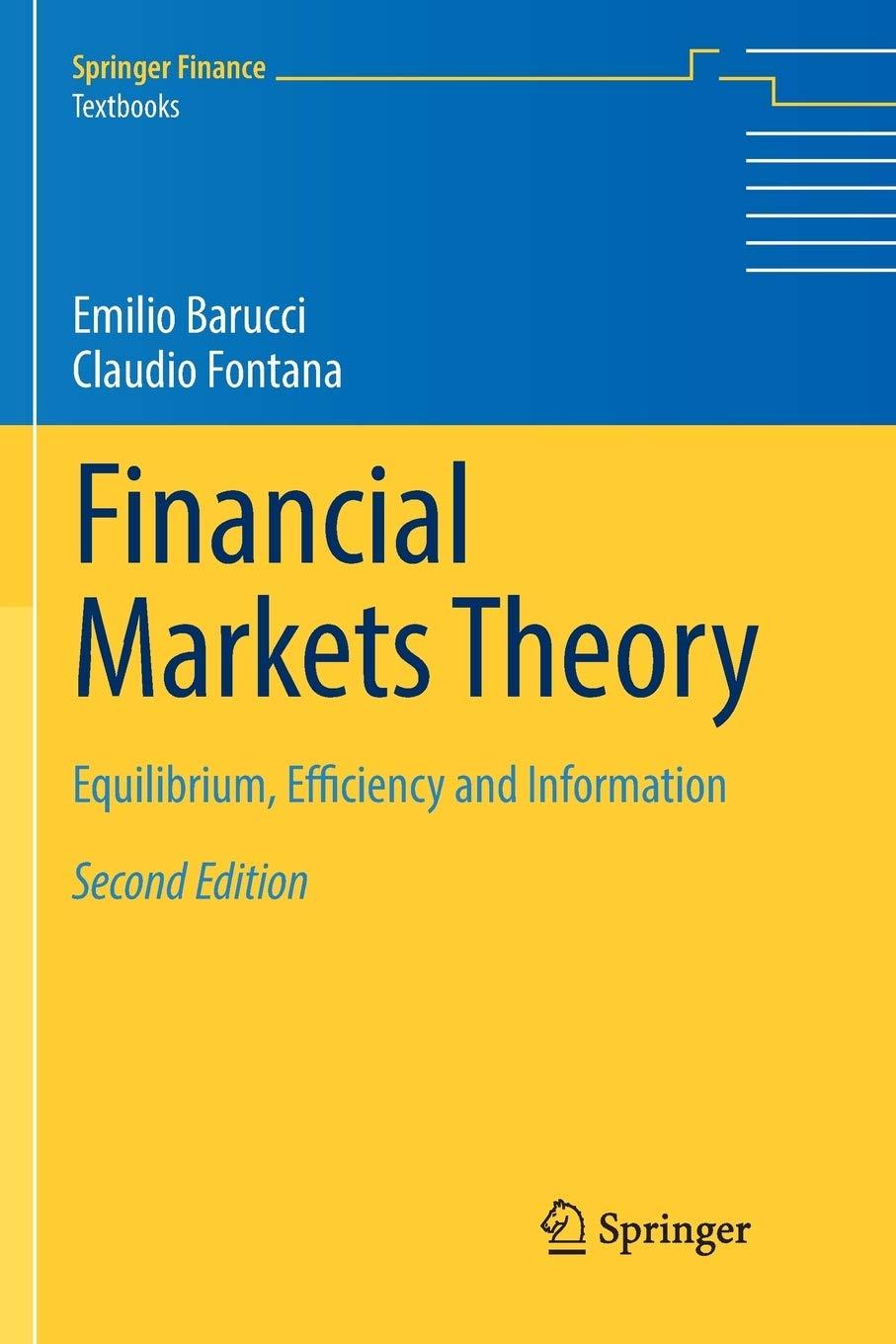Consider the recursive preference functional defined in (9.19), with parameters (alpha in(0,1), varrho in(0,1)) and (delta in(0,1)),
Question:
Consider the recursive preference functional defined in (9.19), with parameters \(\alpha \in(0,1), \varrho \in(0,1)\) and \(\delta \in(0,1)\), in an economy with a single risky asset with return process \(\left(r_{t}\right)_{t=1, \ldots, T}\) and a risk free asset delivering the constant return \(r_{f}\). Denote by \(\left(\theta_{t}\right)_{t=0,1, \ldots, T}\) a trading strategy, measured in terms of the number of units of the risky asset held in the portfolio, and let the couple \(\left(\theta^{*}, c^{*}\right)\) be the trading-consumption self-financing strategy associated with the maximization of the recursive preference functional (9.19). Letting \(\left(W_{t}^{*}\right)_{t=0,1, \ldots, T}\) be the associated wealth process, the corresponding optimal return process \(\left(r_{t}^{*}\right)_{t=1, \ldots, T}\) satisfies
\[W_{t+1}^{*}=\left(W_{t}^{*}-c_{t}^{*}\right) r_{t+1}^{*}, \quad \text { for all } t=0,1, \ldots, T-1\]
As mentioned after Proposition 9.9, relation (9.34) holds as an approximation for the risk premium of the risky asset, i.e.,
\[\begin{align*}\mathbb{E}\left[\log r_{t+1} \mid \mathscr{F}_{t}\right]-\log r_{f}+\frac{\operatorname{Var}\left(\log r_{t+1} \mid \mathscr{F}_{t}\right)}{2} \approx & (1-\gamma) \operatorname{Cov}\left(\log r_{t+1}^{*}, \log r_{t+1} \mid \mathscr{F}_{t}\right) \\& +\varrho \gamma \operatorname{Cov}\left(\Delta \log c_{t+1}^{*}, \log r_{t+1}\right) \tag{9.84}\end{align*}\]
for all \(t=0,1, \ldots, T-1\), where \(\Delta \log c_{t+1}^{*}:=\log c_{t+1}^{*}-\log c_{t}^{*}\) denotes the logarithmic growth rate of the optimal consumption process.
(i) Starting from the relation \(W_{t+1}^{*}=\left(W_{t}^{*}-c_{t}^{*}\right) r_{t+1}^{*}\), prove the following loglinear approximation of the self-financing condition:
\[\Delta \log W_{t+1}^{*} \approx \log r_{t+1}^{*}+\left(1-\frac{1}{\lambda}\right)\left(\log c_{t}^{*}-\log W_{t}^{*}\right)+K\]
for all \(t=0,1, \ldots, T-1\), where \[K:=\log \lambda+(1-\lambda) \frac{\log (1-\lambda)}{\lambda} \quad \text { and } \quad \lambda:=1-\mathrm{e}^{\mathbb{E}\left[\log c_{t}^{*}-\log W_{t}^{*}\right]}\]
(ii) Suppose that the return process \(\left(r_{t}^{*}\right)_{t=1, \ldots, T}\) associated to the strategy \(\left(\theta^{*}, c^{*}\right)\) satisfies the following approximate relation:
\[\begin{equation*}
\log r_{t+1}^{*} \approx \theta_{t+1}^{*}\left(\log r_{t+1}-\log r_{f}\right)+\log r_{f}+\frac{\theta_{t+1}^{*}}{2}\left(1-\theta_{t+1}^{*}\right) \operatorname{Var}\left(\log r_{t+1} \mid \mathscr{F}_{t}\right) \tag{9.85}
\end{equation*}\]
for all \(t=0,1, \ldots, T-1\). By relying on part ( \(i\) ) of the exercise, show that the asset pricing relation (9.84) can be rewritten in the following form:
\[\begin{align*}
& \mathbb{E}\left[\log r_{t+1} \mid \mathscr{F}_{t}\right]-\log r_{f}+\frac{\operatorname{Var}\left(\log r_{t+1} \mid \mathscr{F}_{t}\right)}{2} \approx(1-\gamma) \theta_{t+1}^{*} \operatorname{Var}\left(\log r_{t+1} \mid \mathscr{F}_{t}\right) \\
& \quad+\varrho \gamma\left(\operatorname{Cov}\left(\log r_{t+1}, \log c_{t+1}^{*}-\log W_{t+1}^{*} \mid \mathscr{F}_{t}\right)+\theta_{t+1}^{*} \operatorname{Var}\left(\log r_{t+1} \mid \mathscr{F}_{t}\right)\right) . \tag{9.86}
\end{align*}\]
(iii) Deduce that the optimal demand \(\theta_{t+1}^{*}\) of the risky asset satisfies the following approximate relation:
\[\begin{aligned}
\theta_{t+1}^{*} \approx & \frac{1}{\alpha} \frac{\mathbb{E}\left[\log r_{t+1} \mid \mathscr{F}_{t}\right]-\log r_{f}+\frac{\operatorname{Var}\left(\log r_{t+1} \mid \mathscr{F}_{t}\right)}{2}}{\operatorname{Var}\left(\log r_{t+1} \mid \mathscr{F}_{t}\right)} \\
& -\frac{\alpha-1}{\alpha} \frac{\varrho}{\varrho-1} \frac{\operatorname{Cov}\left(\log r_{t+1}, \log c_{t+1}^{*}-\log W_{t+1}^{*} \mid \mathscr{F}_{t}\right)}{\operatorname{Var}\left(\log r_{t+1} \mid \mathscr{F}_{t}\right)} .\end{aligned}\]
This approximate relation shows that the optimal demand of the risky asset can be decomposed into two terms: a first term which depends exclusively on the risk premium of the asset and a second term which reflects the intertemporal hedging demand (see Campbell \& Viceira [354, Section III] for more details).
Step by Step Answer:

Financial Markets Theory Equilibrium Efficiency And Information
ISBN: 9781447174042
2nd Edition
Authors: Emilio Barucci, Claudio Fontana





